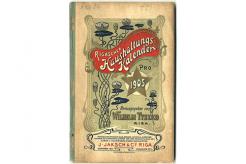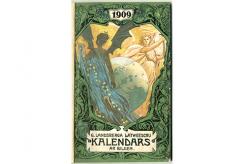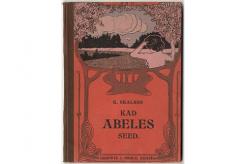




Author: Aija Taimiņa, Dr. philol.
Influences of Art Nouveau are evident in Latvian book design in the early 20th century, most pronouncedly about 1905–1909.
More than 100 publishers were active in Latvian publishing business in the period from 1886 to 1900. All publishers largely focused on democratic readership. Since the early 1880s on, numerous new publishers emerged also in provinces, like Cēsis, Liepāja, Valmiera and Limbaži.
From 1886 to 1900, more than 3500 book titles appeared in Latvian, 290–300 per year. In regard to the total number of titles, Latvian publishing took 4th to 5th place in Russia (after Russian, German, Polish (also Jewish) publishing). About 40% of titles were fiction. Print runs were quite substantial – prose fiction runs were about 2000–3000 copies.
In 1900, there were 34 periodicals in Latvian (newspapers, magazines, almanacs). The number of calendars grew constantly – from 49 publications in 1886 to 60 titles in 1899. Their print runs were huge (up to 30 000 copies).
In the 1880s, the number of printing businesses began to grow rapidly in Latvia. There were already 44 printing houses in Riga in 1897. Most of them were based in Old Town. Riga’s merchants offered publishers and bookbinders largely German-produced printing and lithographic inks (August Trauberg), local and foreign printing and bookbinding machines as well as brass letters and sets of letters (Ulrich Müller) that could also be ordered. The first Latvian printing works was launched in 1869, already 44 printing houses operated in 1897 with 650 employees. There were 50 engine presses and 31 hand-operated presses in Riga; 3 printing works had 119 hand moulds for the casting of movable type. In the late 1890s, the first rotary printing press in Latvia was set up at Ernst Plates’ company. Most successful printing works had also a lithography department; 15 lithographic engine presses and 57 lithographic hand presses were operated at that time. In 1898 printers and letter casters Jānis Āpsītis, K. Lehmann, Ludvigs Grenctāls and Ansis Kalniņš founded the first specialised letter foundry Gutenberg (initially combined with printing works) that supplied the printing houses of Latvia with movable type. It tried to follow the spirit of the age and offered ornamental Art Nouveau ligatures to its customers along with the traditional assortment. The largest Latvian book printing houses in the early 20th century Riga were Gutenberg, Latvija, H. Hempel & Co. and Konrad Emil Heinrich Schnakenburg’sfirm Typographie und Lithographische Anstalt Schnakenburg
More information will be available in the virtual exhibition, which will be established till April 2016.